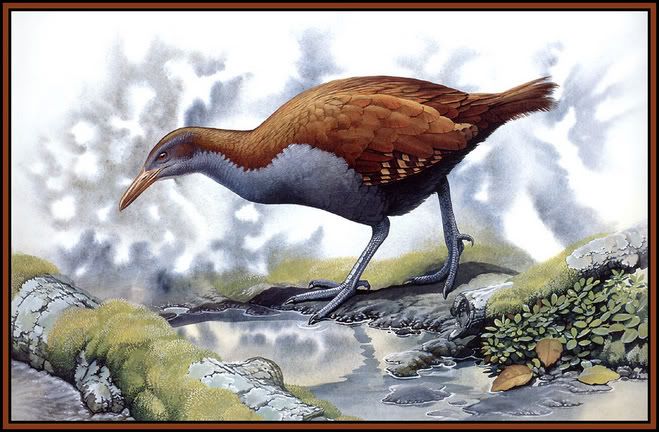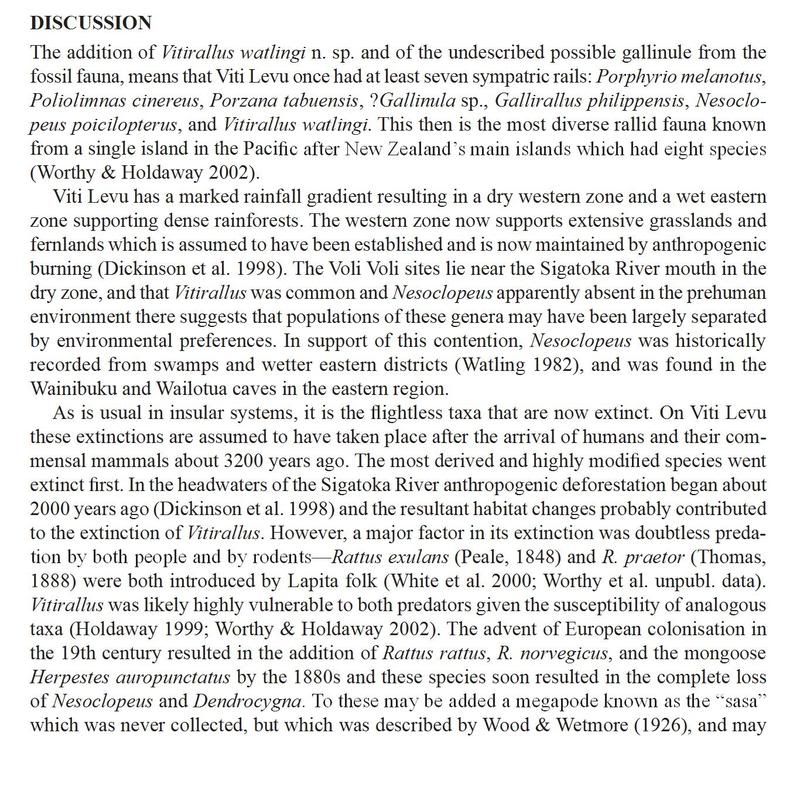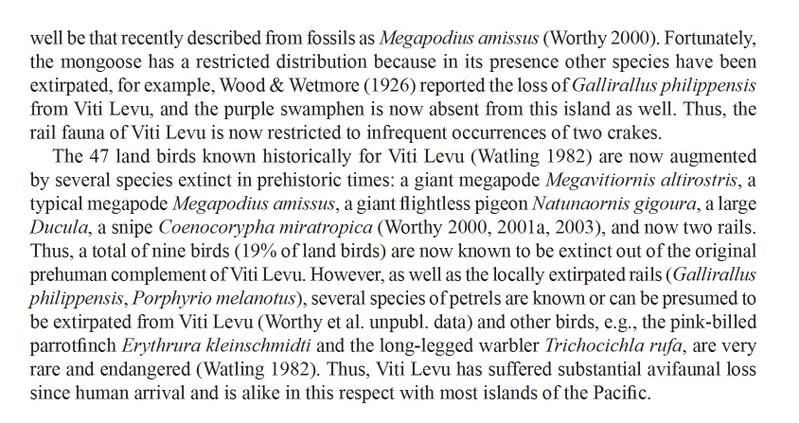|
|
Post by Melly on Mar 12, 2005 15:45:14 GMT
(Nesoclopeus poecilopterus)
The barred-winged rail was a secretive, poorly flighted and evidently nocturnal bird around the size of a half-grown chicken. It inhabited dense swamps and taro gardens. Neither its voice nor food were recorded, though some eggs were collected last century, which are cream-brown in colour, with purplish and red blotches. It is known from less than a dozen museum specimens, all collected during the nineteenth century.
The species was long considered to be extinct until D. T. Holyoak visited Fiji in 1973 and carried out intensive bird surveys for two months. He sighted a barred-winged rail in the Vundiawa area of Viti Levu. It was seen in a 'small valley with old overgrown taro and banana plantations among thickets of bamboo and tall ferns under the cover of tall, well-spaced trees'. Despite much searching, he found no evidence of the species on Taveuni. The species appears to have been rare even before European contact, but the introductions of the mongoose and brown and black rats to Fiji are doubtless responsible for its further decline.
|
|
|
|
Post by another specialist on Jun 8, 2005 9:46:50 GMT
Family/Sub-family RALLIDAE Species name author (Hartlaub, 1866) Taxonomic source(s) Sibley and Monroe (1990, 1993) Synonyms Nesoclopeus poeciloptera Collar and Andrew (1988) Summary Nesocolpeus poecilopterus is known from 12 19th century specimens from Vitu Levu and Ovalau4, reports from Taveuni1 and, in 1973, from Waisa, Vitu Levu3, Fiji. However, two other (non-endemic) rails have become extinct from the islands due to predation by introduced mongooses and cats, and so it seems very likely that N. poecilopterus is also now extinct2. www.birdlife.net/datazone/search/species_search.html?action=SpcHTMDetails.asp&sid=30091&m=0 |
|
|
|
Post by another specialist on Jun 8, 2005 9:48:12 GMT
Justification Bar-winged Rail Nesocolpeus poecilopterus is known from 12 19th century specimens from Vitu Levu and Ovalau, reports from Taveuni and, in 1973, from Waisa, Vitu Levu, Fiji. However, two other (non-endemic) rails have become extinct from the islands due to predation by introduced mongooses and cats, and so it seems very likely that N. poecilopterus is also now extinct. www.iucnredlist.org/search/details.php?species=14655 |
|
|
|
Post by another specialist on Jun 8, 2005 9:51:11 GMT
Bar-winged Rail The Bar-winged Rail Nesoclopeus poecilopterus( Hartlaub, 1866) is another elusive bird which is considered extinct, though recently a sighting has been claimed. It had not been seen since 1890, but was reported in 1973 by David Holyoak, who caught a glimpse of a bird near Vunindawa on Vitu Levu which seemed to fit the description of the Bar-winged Rail. It is therefore possible that the species still survives in the inaccessible marshes of the Fiji Islands. Only a few museum specimens of the Bar-winged Rail remain. The three skins in the National Museum of Natural History were, like those of the Samoan Wood Rail, obtained from the Godeffroy Museum.  Bar-winged Rail  Samoan Wood Rail and Bar-winged Rail Photograph by Rosamond Purcell from Swift as a Shadow. © 1999. www.naturalis.nl/300pearls/default.asp |
|
|
|
Post by another specialist on Jul 26, 2005 4:07:06 GMT
Bar-winged rail (Nesocolpeus poecilopterus) The best available scientific and commercial information indicates that the bar-winged rail is extinct, and therefore listing of this species is not warranted. It is known from twelve 19th Century specimens from Vitu Levu and Ovalau, reports from Taveuni, and in 1973, from Waisa and Vitu Levu, all in Fiji (Holyoak 1979, as cited in BirdLife International 2000). This was a flightless bird that inhabited remote forested areas, old overgrown plantations, and possibly lowland swamps (Pratt et al. 1987). Two other rails from these islands have become extinct due to predation by introduced mongooses (Herpestes spp.) and cats (Felis domesticus). BirdLife International (2000) classifies the bar-winged rail as extinct. www.scricciolo.com/listing_e-mail.htm |
|
|
|
Post by Melanie on Oct 30, 2005 4:31:17 GMT
another synonym: Nesoclopeus poecilopterus poecilopterus
|
|
|
|
Post by another specialist on Oct 30, 2005 6:26:47 GMT
Fiji Bar-winged Rail (Rallina [Nesoclopeus] poeciloptera) last collected ca. 1890 on Viti Levu flightless island ground-nesting forest/freshwater swamp dweller endemic to Fiji Islands specimens in Boston, London, New York disappeared after introduction of mongoose References: Greenway, J. C. Extinct and Vanishing Birds of the World QL676.7.G7 1967 p.230 Ziswiler, V. Extinct and Vanishing Animals QL88.Z513 1967 p.108 www.uwsp.edu/geo/faculty/heywood/geog358/extinctb/FBWRail.htm |
|
|
|
Post by another specialist on Oct 30, 2005 6:28:22 GMT
N. poecilopterus Bar-winged Rail Sometimes considered conspecific with N. woodfordi as N. poecilopterus Bar-winged Rail. Extinct? Res Fiji (Viti Levu, Ovalau. Extinct Taveuni). www.rosssilcock.com/9.htm |
|
|
|
Post by another specialist on Nov 7, 2005 7:16:06 GMT
 gap in nature |
|
|
|
Post by another specialist on Sept 7, 2008 11:37:46 GMT
|
|
|
|
Post by another specialist on Sept 7, 2008 12:00:47 GMT
  The fossil rails (Aves: Rallidae) of Fiji with descriptions of a new genus and species Trevor H. Worthy1 |
|
|
|
Post by another specialist on Dec 9, 2008 13:03:58 GMT
1984 Print Lansdowne  This is an original 1984 color print of three rails: the Lord Howe Island Wood Rail (top), an endangered species found on the two highest forested peaks of Lord Howe Island; the Barredwing Rail (middle), which has been recorded on the Solomon Islands and Fiji; and the New Caledonia Wood Rail (bottom), a flightless forest rail found in the remote rain forests of New Caledonia. original for sale on ebay |
|
Deleted
Deleted Member
Posts: 0
|
Post by Deleted on Mar 23, 2010 10:15:35 GMT
Bar-winged Rail ( Nesoclopeus poecilopterus) bird:  and egg:  source: 'Beitrag zur Fauna Centralpolynesiens. Ornithologie der Viti-, Samoa- und Tonga-Inseln; von O. Finsch und G. Hartlaub. Mit 14 nach der Natur lithographirten und colorirten Kupfertafeln. Halle, H. W. Schmidt, 1867.' www.biodiversitylibrary.org
|
|
|
|
Post by another specialist on Sept 23, 2012 12:42:10 GMT
|
|
|
|
Post by Sebbe on Jul 4, 2014 19:50:51 GMT
Here is the paper in which D.T. Holyoak described his encounter with this species on Viti Levu in 1973, though some sources treats this sighting as unconfirmed. Holyoak, D. T. 1979. Notes on the birds of Viti Levu and Taveuni, Fiji. Emu 79: 7-18Notes are given on the status and biology of Fijian birds based on visits to Viti Levu and Taveuni during 1973. Few Fijian landbirds are endangered and most of the endemic forms are still common. The flightless rail Nesoclopeus poecilopterus and the warbler Trichocichla rufa, both of which have been feared extinct since the last century, were rediscovered on Viti Levu. The Taveuni population of Petroica multicolor is given a new subspecific name. It is suggested that recent reports of 'unknown' landbirds in Fiji may be based on misidentifications. Field notes on habitat preferences, diet, general behaviour and vocalizations are summarized for most of the species that were seen. www.publish.csiro.au/paper/MU9790007.htm |
|
|
|
Post by Sebbe on Jul 4, 2014 19:57:56 GMT
|
|
|
|
Post by Melanie on Oct 28, 2014 16:33:48 GMT
|
|
|
|
Post by surroundx on Apr 13, 2015 9:19:54 GMT
|
|